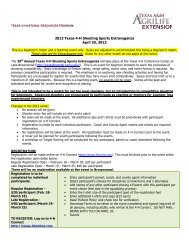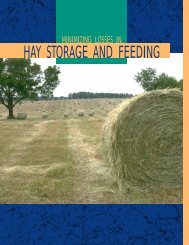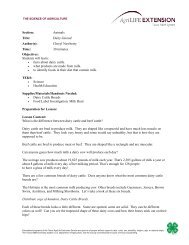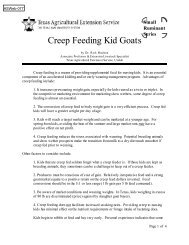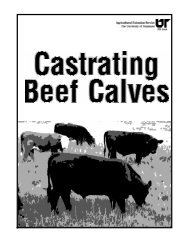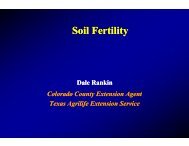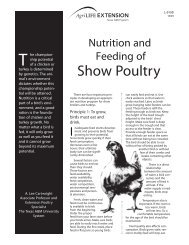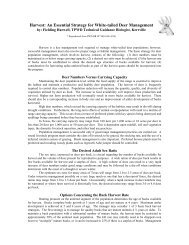Pinkies, What's the big Deal?
Pinkies, What's the big Deal?
Pinkies, What's the big Deal?
Create successful ePaper yourself
Turn your PDF publications into a flip-book with our unique Google optimized e-Paper software.
<strong>Pinkies</strong>, What’s <strong>the</strong> <strong>big</strong> <strong>Deal</strong>?South Plains Ag Conference andTrade ShowScott A. RussellExtension Agent –IPM, TCE
Economic Infestations 2003
Pink Bollworm Life CycleAdults emerge in springEgg laying on cottonplant, hatch 3-4 daysPupal stage 7-8days; overwintersLarval stage 12-15 days
Pink Bollworm Life Cycle• Adult-3/8”, graybrown– emerges in spring– lives 10-14 days– lays 200 eggs• Eggs laid– early season• vegetative parts– mid to late season• young bolls
Pink Bollworm Life Cycle• Larvae– early season-squares– mid-late season-bolls– hatch 3-4 days– young-white/black head– tunnel into square or bollwithin 1 hr– 12-15 days– mature-1/2”; pink bands
Pink Bollworm Life Cycle• Mature larvae– cut out of bloom/boll– pupate in soil/at soilsurface– 7-8 days• Complete life cycle– approx. 30 days– 4-5 generations/yr
Pink Bollworm Life Cycle• Winter survival– overwinter as mature larvae• bolls, seed, cotton litter, soil– in spring larvae pupate– adults emerge• many suicidal• need match-head square tosurvive
Pink Bollworm Control• Control is a year round task• Spring: delay planting to improve seedling healthand vigor– “planting window”– Pre-plant watering better than “watering –up”• Manage for early maturity– terminate irrigation by August 25– use harvest aids• Plant Bollgard® Varieties = 99% control
Pink Bollworm Control inPre-bloom Cotton• Winter/spring irrigation may increase suicidalemergence*• Monitor adult moth emergence/activity withpheromone traps• Treatment warranted when trap catches averagemore than 5 moths per night; Pyrethroids• At 1/3 grown square discontinue insecticidetreatment to allow natural enemy populations torebound prior to first egg laying
Pink Bollworm Control• Adult pheromone traps• from pinhead to 1/3 grown square• threshold-5 moths/trap/night• Trap density at least 1 trap per 30 acres• Monitor/check traps every 2-3 days• Pheromone traps are only an indicator of adultactivity, field monitoring is still essential• Plant Bollgard® Varieties
Pink Bollworm Control afterCotton Blooms• Must be based on:– Crop monitoring, bloom and bollinfestation level– Trap catches onlyindicate adult mothactivity, not egg laying& larval survival• Plant Bollgard®Varieties
Pink Bollworm Control afterCotton Blooms• Proactive approach is based on trap catches– 5 plus moths per night = scout field, determineinfestation level in blooms and small bolls, 10-15%consider treatment– Recheck traps in 4 days, 5 per night = treat again 5-7days following previous application• Continue until <strong>the</strong> top crop you expect to harvestis “safe”• Cut off water by August 25 to reduce food qualityfor late season larvae
Pink Bollworm Control afterCotton Blooms• Crop Monitoring• More accurate reflection of infestation levels• Collect and examine 40-50 quarter sized boll,from all across <strong>the</strong> each field• Carefully cut and examine for pink bollworm lavaor damage• 10-15% boll infestation rate should triggertreatment
Pink Bollworm Control afterCotton Blooms• Use a combination of trapping adults andCrop Monitoring• Traps indicate adult activity• Low numbers of moths in traps does notalways mean low field activity
Pink Bollworm ControlLate Season• Insecticide treatments end when lastbolls to be harvested are rock hard• Terminate irrigation by August 25– Reduce quality food for late seasongenerations• Use harvest aids that cause– Immature fruit drop– Defoliation• Early and thorough harvest– Removes infested bolls
Pink Bollworm ControlLate Season• Late-Season Management Cont.– Reduce overwintering populations by• Stalk destruction & Plow-down• Plow down at least 6”
Insecticide ApplicationSuggestions• Use Pyrethroids, <strong>the</strong>se are adulticides• Apply late evening, moths are most active• Utilize a “skip swath” method ofapplication• Monitor both adult and larval activity
Some Things We Don’t KnowAbout PBW• How are <strong>the</strong>y distributed?– needed to determine most efficient samplingplan• Where majority of larvae overwinter– seed, bolls, leaf litter, soil ?• How effective is plow down?• How long after irrigation do moths emerge& what % emergence can we expect?
Some Things We Don’t KnowAbout PBW• When do most PBW enter overwintering stage?– Need DD models for better prediction in West Texas• What is relationship between Adult trap numbersand egg lay?– Can adult traps be used to time treatments?• How are PBW populations affected byinsecticides?



